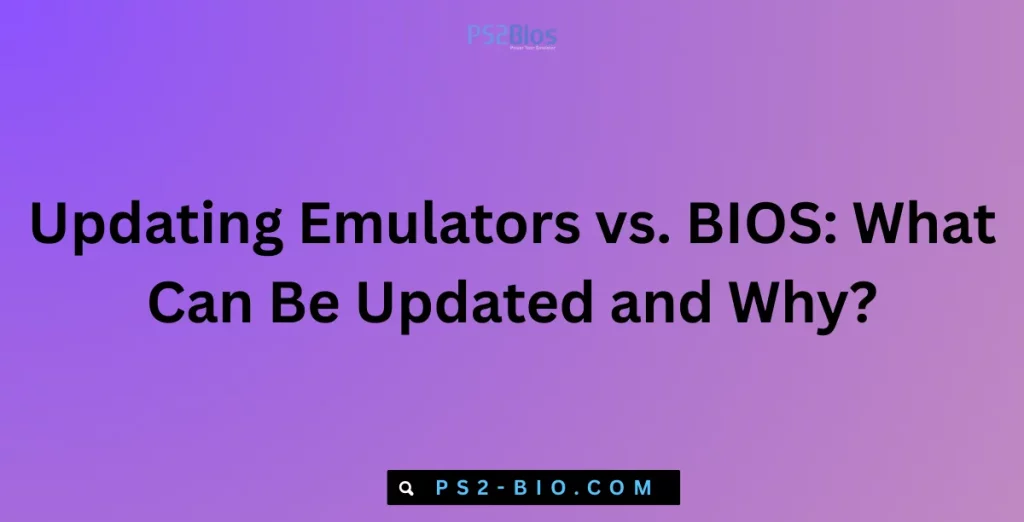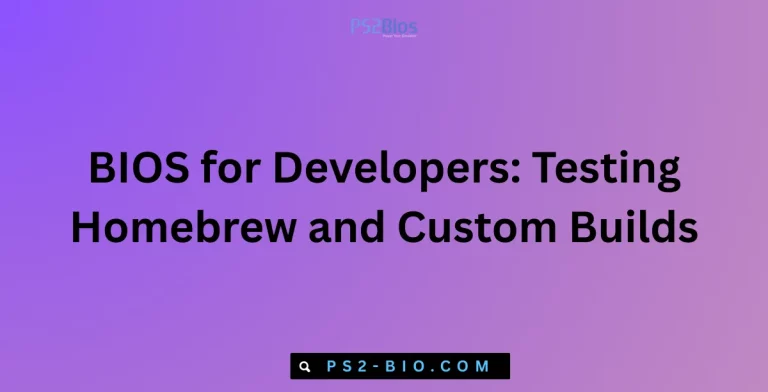Updating Emulators vs. BIOS: What Can Be Updated and Why?
Are you confused about whether to update your emulator or BIOS for smoother gaming? Understanding the differences, what can actually be updated, and why it matters can save time, prevent errors, and ensure your games run correctly across devices and systems.

Understanding Emulators and BIOS
An emulator is software that replicates a gaming console on your computer, allowing you to play console games without the original hardware. Popular examples include PCSX2 for PlayStation 2, Dolphin for GameCube/Wii, and PPSSPP for PSP.
The BIOS (Basic Input/Output System) is firmware embedded in the console or device that starts hardware and ensures games and software run correctly. In consoles like PlayStation, BIOS files are required by emulators to mimic the original system.
Updating emulators and BIOS serve different purposes. While emulators evolve with new features, bug fixes, and performance improvements, BIOS updates often address hardware-level compatibility or fix critical errors for original consoles.
What Can Be Updated in Emulators
- Software Version
Emulator developers frequently release new versions. Updates can include speed optimizations, interface improvements, and additional plugin support. For example, PCSX2 1.7.0 introduced enhanced multi-threaded rendering for better frame rates. - Plugins and Add-ons
Emulators often rely on external plugins for graphics, audio, or input devices. Updating plugins can fix stuttering, audio lag, or controller issues without changing the main emulator code. - Game Compatibility Lists
Developers continuously test new games. Updates often expand supported game lists, ensuring previously unplayable titles can now run. - Performance and Stability
Updates often reduce crashes, optimize memory usage, and fix bugs related to specific operating systems like Windows 11 or macOS Ventura.
What Can Be Updated in BIOS
- Firmware Version
BIOS updates, typically released by console manufacturers, correct hardware-level issues, improve stability, or address security vulnerabilities. For example, PlayStation 2 BIOS versions vary by region and may have game-specific fixes. - Regional Compatibility
Some BIOS updates enable support for imported games from other regions or new hardware accessories, improving the console’s flexibility. - Hardware Bug Fixes
Older consoles sometimes suffer from glitches like memory errors, incorrect disc reading, or overheating protection issues. BIOS updates can correct these at a firmware level.
Important: Unlike emulators, BIOS cannot add new features to games or systems; it is limited to correcting issues and maintaining console integrity.
Key Differences Between Updating Emulators and BIOS
| Feature | Emulator Update | BIOS Update |
|---|---|---|
| Purpose | Improve software performance, compatibility, and interface | Correct hardware-level issues and maintain stability |
| Frequency | Frequent, often several times a year | Rare, usually only for critical fixes |
| Effect on Games | Can enhance graphics, load times, and bug resolution | Ensures games run as intended by original console |
| User Risk | Low; can revert to older versions if needed | Moderate to high; incorrect update can damage hardware |
| Flexibility | High; supports plugins, skins, and additional features | Limited; firmware updates are fixed by manufacturer |
Why Emulator Updates Are Important
- Enhanced Game Performance
Updates optimize rendering engines and CPU usage, allowing games to run at higher resolutions or frame rates. For example, Dolphin emulator 5.0 added Vulkan API support, improving game speed and graphics fidelity. - Bug Fixes
Developers frequently patch crashes, freezes, and input errors, making gameplay smoother. - New Hardware Support
Updates ensure compatibility with modern GPUs, controllers, and operating systems, preventing lag or unresponsive controls. - Security Enhancements
Though less critical than in BIOS, emulators occasionally fix vulnerabilities in file handling or memory management, reducing the risk of crashes or file corruption.
Why BIOS Updates Are Critical
- Hardware Integrity
BIOS updates prevent long-term hardware damage, such as disc drive errors or overheating issues in consoles like PlayStation 2. - Game Compatibility
Some updates allow previously unplayable games to run correctly by fixing memory addressing or timing issues. - Firmware Security
Updates can patch firmware-level vulnerabilities, which is important for consoles still connected to networked environments. - Stability
Correcting bugs at the BIOS level can reduce system crashes, freezing, or startup errors, providing a more reliable gaming experience.
How to Safely Update Emulators
- Backup Current Setup
Always save current emulator folders, game saves, and configuration files before updating. - Use Official Sources
Download updates only from official emulator websites like PCSX2.net or Dolphin-Emulator.com to prevent malware. - Check Change Logs
Review the release notes to understand what issues are addressed and whether your system will benefit. - Test Updates Gradually
Run a few games after updating to verify performance and stability before fully committing.
How to Safely Update BIOS
- Verify Manufacturer Instructions
BIOS updates are region-specific. For PlayStation consoles, ensure you use the correct BIOS version to avoid hardware malfunction. - Use Reliable Media
Always apply BIOS updates via official sources or verified firmware files. Avoid unofficial downloads that could brick your console. - Do Not Interrupt Updates
Never power off the console during a BIOS update, as this can permanently damage hardware. - Backup Data When Possible
For consoles with storage memory, backup saves before updating BIOS to prevent potential data loss.
Common Myths About Updates
- “Updating BIOS Improves Graphics”
BIOS updates fix hardware issues but do not enhance graphics. Emulator updates, not BIOS, improve visual performance. - “Emulators Don’t Need Updates”
Without updates, games may experience crashes, slowdowns, or unplayable titles, making updates essential. - “Any BIOS Version Works for All Regions”
BIOS is region-specific. Using an incorrect version may prevent games from loading. - “Updates Always Fix All Problems”
Updates improve stability but cannot guarantee perfect gameplay. Hardware limitations or poorly optimized games can still cause issues.
Recommended Update Practices
- Emulators: Update frequently to access new features, plugins, and bug fixes. Maintain multiple versions if needed for compatibility.
- BIOS: Update only when necessary, such as critical game fixes or hardware issues. Avoid unnecessary updates to reduce risk.
- Always Backup: For both emulators and BIOS, maintain backups to restore previous functionality if updates fail.
Conclusion
Updating emulators and BIOS serve different purposes but are both crucial for a smooth gaming experience. Emulator updates improve performance, add features, and fix bugs, while BIOS updates maintain hardware stability and ensure original game compatibility.
Knowing what can be updated and why helps prevent errors, enhance gameplay, and protect your system. Regular maintenance and careful update practices ensure you enjoy a reliable and efficient gaming setup.






